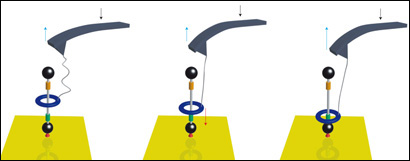
Posted on 08/22/2011 11:50:22 PM PDT by neverdem
Researchers in the UK and Belgium have measured the work performed by a single manmade molecule. The result demonstrates that manmade molecules can generate similar forces to natural molecular machines, and could help chemists to design artificial molecular machines for meaningful tasks.
Many biological molecules can perform useful work. The protein motors kinesin and dynein, for example, transport cargo around cells using the chemical energy stored in ATP, the chemical fuel of biological systems. Scientists have created their own molecular machines that perform useful work, such as moving liquid droplets uphill or rotating microscale objects. But these synthetic machines have all had to work collectively, perhaps in groups of billions or more.
David Leigh, of the University of Edinburgh, and colleagues, have now managed to extract work from a single manmade molecule. The molecule is a rotaxane that comprises a molecular ring with a long axle running through it. The ring can move along the length of the axle, but it prefers to stay at one end where it can form several hydrogen bonds with the spindle.

|
The rotaxane can exert a force of 30pN
© Nat. Nanotechnol.
|
Leigh's group anchored the axle to a gold surface, and attached a curly polymer chain to the ring. To the other end of this polymer chain they attached the tip of an atomic force microscope (AFM), a device that can measure minute forces via the deflection of a cantilever. As they pulled the AFM tip, the polymer first unfolded and then pulled the ring away from the hydrogen bonds to the other end of the axle. However, once the researchers stopped pulling the AFM tip, the ring could move with random thermal fluctuations, and gradually took itself back to its preferred site.
'This last part is a bit like a dog held on a loose leash coming across a fire hydrant, and then exerting a force on the holder of the leash,' says Leigh.
After measuring a few hundred push-and-relax cycles, Leigh's group built up a picture of the force generated by the rotaxane molecule: 30pN, which translates to mechanical work of about 6 kcal mol-1. Kinesin and myosin produce forces in the range 5 to 60pN.
Dean Astumian, an expert in molecular motors at the University of Maine, US, says the work complements previous work performed by Fraser Stoddart of Northwestern University, US, and others in 2005. In these experiments, Stoddart's group did not initiate any push-and-relax cycles, but instead examined how the mechanical behaviour of a rotaxane changed when it was switched between different chemical states.
'The next logical step would be to combine these two results into a single experiment,' Astumian says, adding: 'Such an experiment would provide a remarkable insight into the principles of transduction between chemical and mechanical energy - an essential element of operation of many molecular machines.'
References
P Lussis et al, Nat. Nanotechnol., 2011, DOI: 10.1038/nnano.2011.132Also of interest
Rotaxane molecule seen in action
16 June 2010
Researchers directly observe the ring of a rotaxane molecule switch positions along its thread in response to an electrochemical stimulus
First DNA rotaxane
18 April 2010
German researchers devise a way of threading DNA through a hoop to create a wheel and axle structure
Metal ions give rise to threaded molecules
28 April 2009
Researchers use metal ions to guide synthesis of 'double-threaded' [3]rotaxane
Modified ecstasy 'attacks blood cancers'
Major ALS breakthrough (and Alzheimer's?)
World's Oldest Fossils Found in Ancient Australian Beach
FReepmail me if you want on or off my health and science ping list.
Ping

Disclaimer: Opinions posted on Free Republic are those of the individual posters and do not necessarily represent the opinion of Free Republic or its management. All materials posted herein are protected by copyright law and the exemption for fair use of copyrighted works.